- Регистрация
- 17 Февраль 2018
- Сообщения
- 22 703
- Лучшие ответы
- 0
- Баллы
- 2 093
Offline
At a glance
Expert's Rating
Pros
Nvidia’s already ferocious RTX 4080 gets a small performance boost and a big price cut for this Super-fied variant. It makes a world of difference. The cheaper GeForce RTX 4080 Super instantly upsets its rivals and becomes the best modern 4K graphics card under $1,000.
Nvidia sure has been fixing the biggest problems in its high-end GeForce RTX 40-series graphics card lineup with the newly announced “Super” series of refreshes. First, the RTX 4070 Super added 15 to 20 percent more performance to better fight AMD’s Radeon RX 7800 XT rival. Then, the RTX 4070 Ti Super upgraded the original’s memory system to better run games at 4K. Better yet, those cards still cost the same as their non-Super predecessors.
The biggest problem with the original RTX 4080? Its price. There was no denying its potency, but the 4080 debuted at $1,200, a staggering $500 more than last generation’s RTX 3080 — a 71 percent price increase for a mere 30 percent performance increase. Ick.
While the new GeForce RTX 4080 Super indeed offers some small speed increases, Nvidia once again aimed to plug the original’s weak spot. The RTX 4080 Super costs $999, a $200 improvement over the vanilla version (which is being discontinued).
Is it enough to make GeForce RTX 4080 Super competitive with AMD’s Radeon RX 7900 XTX, our current pick for the best 4K gaming GPU? Let’s take Nvidia’s own Founders Edition model for a spin and find out.
Nvidia GeForce RTX 4080 Super specs and features
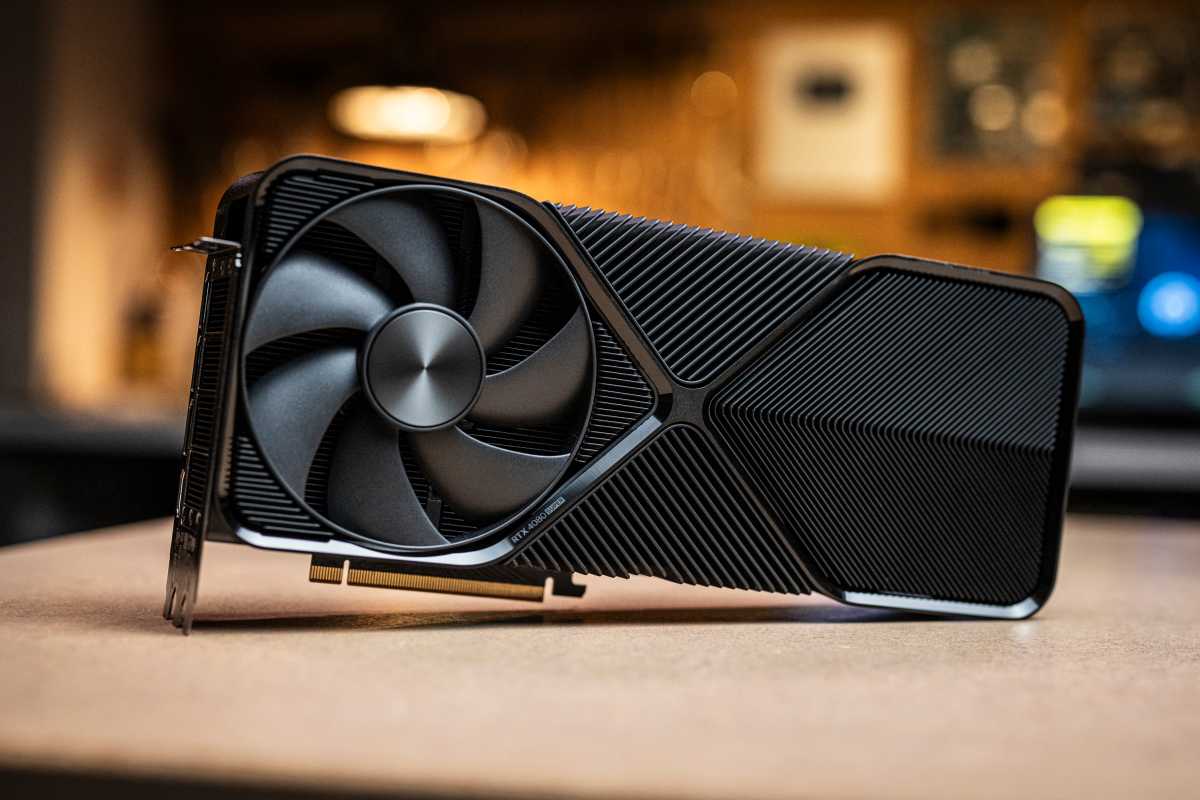
Adam Patrick Murray / IDG
The GeForce RTX 4080 Super still uses the same AD103 graphics die that powered the original 4080, but the full-fat version.
The vanilla 4080 disabled two “streaming multiprocessors” full of graphics, ray tracing, and tensor cores; the Super restores those, bringing the CUDA count total from 9,728 in the 4080 to 10,240 in the Super, a modest 5 percent increase. Nvidia also increased the Boost Clock speed from 2.51GHz to 2.55GHz, and nudged the memory clock speed upwards as well.
All told, Nvidia says the Super should be roughly 2 to 3 percent faster than the vanilla 4080 on average, and our own benchmark testing backs that up. The real draw here is the price cut — though considering the original RTX 4080 was a beastly performer for play and work alike, that’s not necessarily a bad thing.
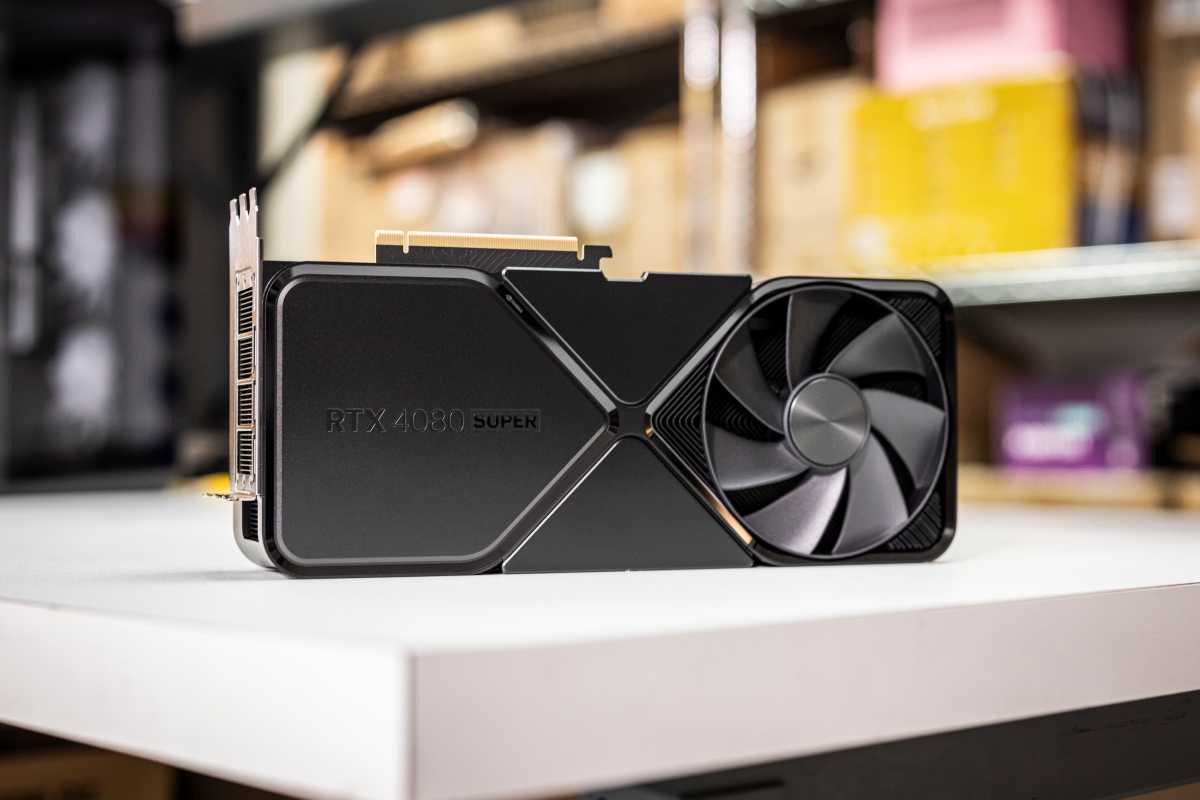
Adam Patrick Murray / IDG
With 16GB of ultra-fast GDDR6X memory across a 256-bit bus, the RTX 4080 Super has no problem blowing through games at high detail settings even at 4K resolution (as you’d hope in a $1,000 graphics card). Impressively, Nvidia managed to eke out the extra performance without increasing the GPU’s power requirements.
The GeForce RTX 4080 Super supports all the modern Nvidia features that can push performance even higher, such as DLSS 3.5, Frame Generation, the latency-reducing Nvidia Reflex, G-Sync monitors, and more. Creative types will appreciate the dual AV1 encoders, optional Studio driver support, and (if you’re a streamer) excellent Nvidia Broadcast tools.
Nvidia’s Founders Edition design largely mirrors that of the original, from the (girthy) dimensions to the 16-pin 12VHPWR cable to the output setup: one HDMI 2.1, three DisplayPort 1.4a connections. The most notable change here is the color scheme, as the Super variants embrace a gorgeous blacked-out aesthetic with strong Darth Vader vibes. Nvidia’s custom cooler always impressed — visually, and practically — and it’s no different this time around.
But how does it handle? Let’s get to the benchmarks.
Our test system
Adam Patrick Murray, the smiling face of PCWorld on YouTube, performed all the following benchmarks on a custom-built system, using the latest publicly available drivers for all GPUs except the RTX 4080 Super itself, which used early 551.22 drivers supplied to the press.
Each benchmark run was conducted a minimum of three times, with the average value taken. We’re comparing the new $999 RTX 4080 Super against the original $1,200 RTX 4080 Super, the $999 Radeon RX 7900 XTX, and Nvidia’s step-down RTX 4070 Ti. Ideally, we’d have RTX 4070 Ti Super benchmarks here, but we’re still in the process of testing that card. It should be about 10 percent faster than the vanilla 4070 Ti results shown below.
Nvidia GeForce RTX 4080 Super performance benchmarks
Let’s start at 4K resolution, as that’s the most demanding common scenario for these ultra-high-end graphics cards, then look separately at 1440p performance.
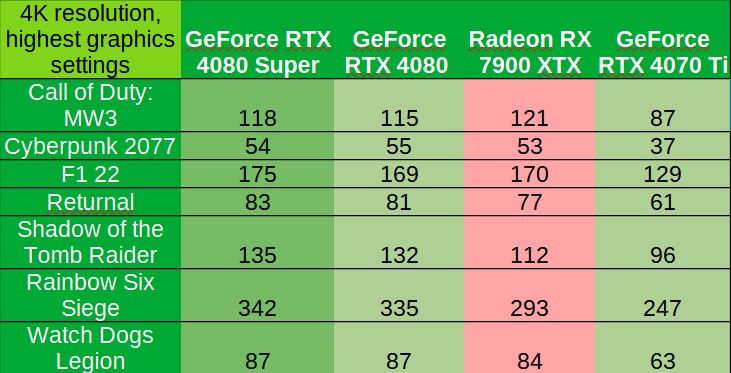
(Right-click and select ‘open in new tab’ for full-sized image.)
Adam Patrick Murray / IDG

(Right-click and select ‘open in new tab’ for full-sized image.)
Adam Patrick Murray / IDG
The RTX 4080 Super and Radeon RX 7900 XTX trade blows at both resolutions; Nvidia wins big in some titles, AMD wins big in some others, and they’re neck-and-neck in the rest. In general, Nvidia’s architecture runs a bit better at 4K resolution, while the Radeon has a slight edge at 1440p.

(Right-click and select ‘open in new tab’ for full-sized image.)
Adam Patrick Murray / IDG
To gauge the efficiency of the ray tracing cores, we also tested Cyberpunk 2077 at the RT medium setting, with both AMD and Nvidia GPUs using AMD’s open FSR 2.0 upscaling feature in the game. In addition, we flipped ray tracing on in Returnal.
AMD has made huge strides in ray tracing, but it remains a bastion for Nvidia GPUs. The RTX 4080 Super tromps the Radeon RX 7900 XTX at Medium RT, and as you ramp up the rays, Nvidia GPUs only widen the gap. You’ll need a high-end Nvidia graphics card like the RTX 4080 Super to run Cyberpunk’s glorious, fully path-traced Overdrive mode at anything above slide-show frame rates, and you can only do that by leveraging Nvidia’s full feature arsenal of DLSS 3.5, Frame Gen, and Reflex.

(Right-click and select ‘open in new tab’ for full-sized image.)
Adam Patrick Murray / IDG
We also tested the power draw and maximum GPU temperature of these graphics cards. Adam tested these by running a loop of F1 22’s Miami track at 1440p/Ultra High preset, with no ray tracing or upscaling enabled, and noting the maximum result for each test.
Hot damn does the Radeon RX 7900 XTX suck down some juice. Impressively, Nvidia made the RTX 4080 Super even more power efficient than its namesake, despite delivering a smidge more performance.
Should you buy the GeForce RTX 4080 Super?
While I couldn’t recommend the original RTX 4080 over the Radeon RX 7900 XTX at its chest-clutching $1,200 price, the GeForce RTX 4080 Super’s $999 price tag makes it much more competitive. In fact, I’d opt for Nvidia’s refreshed penultimate GPU over AMD’s champion now.
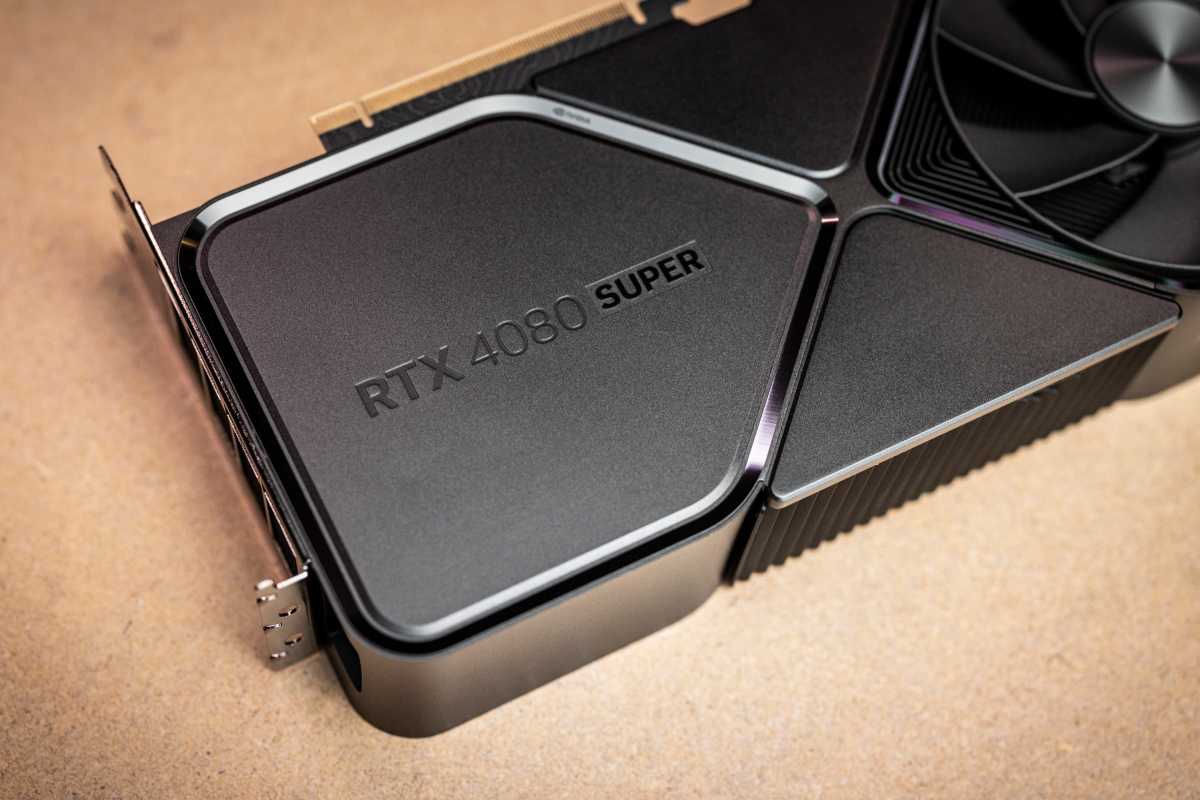
Adam Patrick Murray / IDG
The performance upgrades in the 4080 Super are perfunctory and negligible; it’s the price drop that matters. The Super and the 7900 XTX both deliver screaming-fast frame rates in traditional games, trading blows left and right. That’s what made the Radeon so appealing versus the original 4080, especially with Nvidia’s card having such an exorbitant markup. But by matching the 7900 XTX’s $1,000 MSRP, Nvidia’s extras help the 4080 Super claim dominance.
The GeForce RTX 4080 draws massively less power than its AMD rival to deliver similar frame rates in traditional games. Flip on ray tracing and Nvidia holds a gargantuan lead, with stellar AI-powered features like DLSS, Frame Generation, and Ray Reconstruction pushing both speed and performance advantages to 11. Features like Nvidia Broadcast and Reflex hold deep practical appeal; RTX Video Super Resolution uses AI to make ugly videos beautiful. And Nvidia maintains a strong lead in most creative and machine learning/AI workloads if you like to put your GPU to work when you’re not playing — witness the dual AV1 encoders in the 4080 Super.
Taken as a whole package — performance, ray tracing, power efficiency, features, even prosumer tasks — Nvidia’s GeForce RTX 4080 Super is the clear choice in its price range.
Radeon RX 7900 XTX
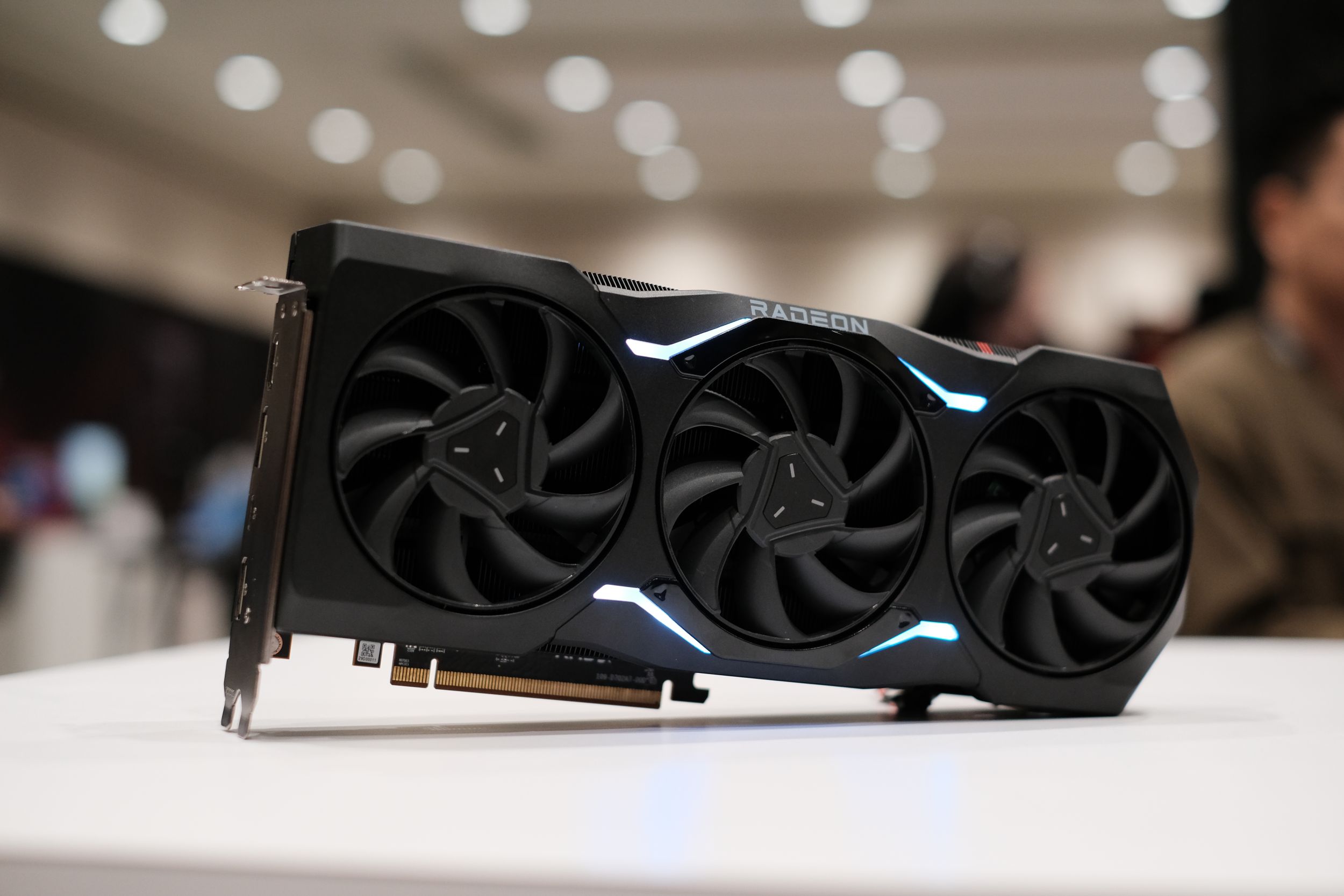

Read our review
AMD has alternatives to some of those features (FSR, Radeon Anti-Lag+) and some key software wins of its own, like Smart Access Memory and the driver-level AMD Fluid Motion Frames. In general, however, Nvidia’s software features are more polished and performant. When you’re spending borderline four figures on a graphics card, the extras matter.
Taken as a whole package — performance, ray tracing, power efficiency, features, even prosumer tasks — Nvidia’s GeForce RTX 4080 Super is the clear choice in its price range. This is the graphics card you want for 4K gaming without going over $1,000. You can often find the Radeon 7900 XTX on sale for $950 or so, but I’d still pick up the 4080 Super without hesitation given that option. At the high-end, where everything matters, I wouldn’t consider the AMD option unless it was on sale for $900 or (ideally) less, despite it being a fine 4K GPU in its own right.
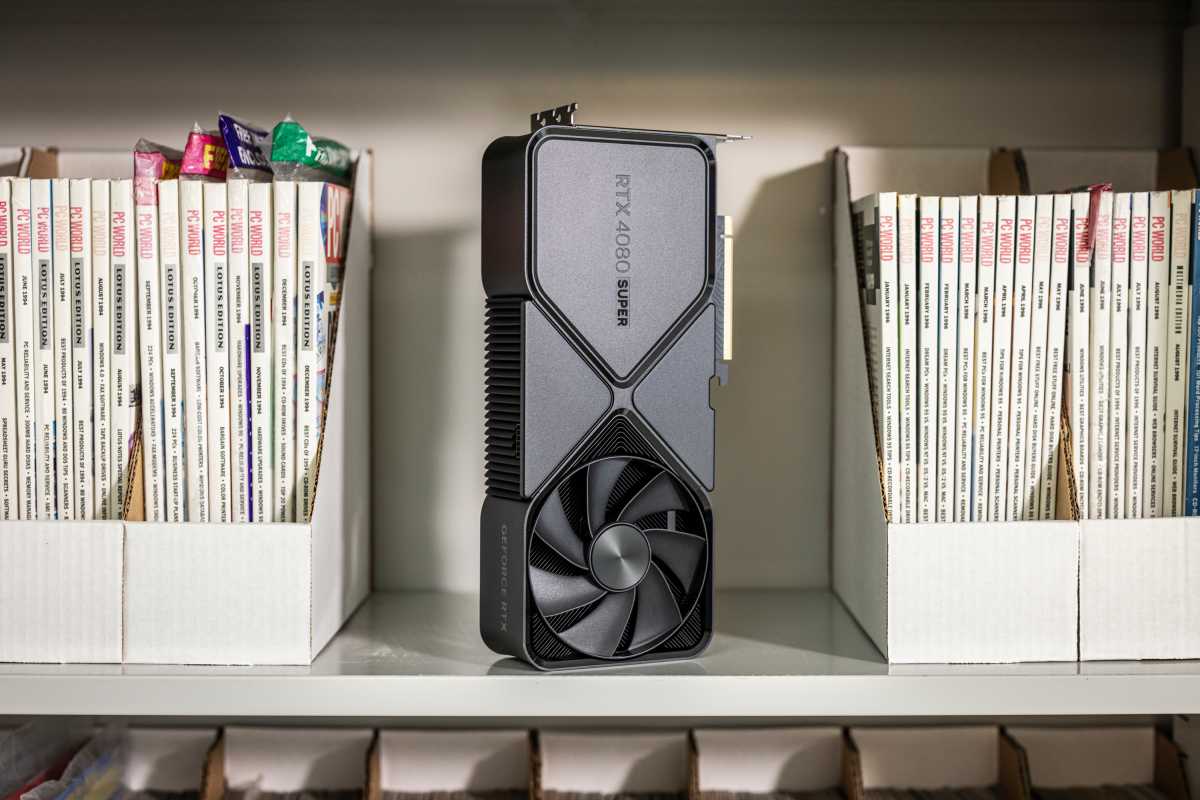
Adam Patrick Murray / IDG
That said, while the RTX 4080 Super’s $200 price drop helps this ferocious graphics card finally compete against its rival, I’d still like to see both of those cards dip even more. Remember that the RTX 3080 launched at $699; the 4080 Super would be spectacular if it cost $800, and much easier to recommend at $900. A thousand bucks is a whole heap of cash.
If you want 4K gaming, excellent ray tracing, and Nvidia features at a slightly lesser price, the $799 GeForce RTX 4070 Ti Super is also worth considering now that it has 16GB of memory and a wider memory bus. It isn’t as fast as the 4080, obviously, but should still get the job done. Or if you want the ultimate gaming experience, there’s always the GeForce RTX 4090, though it’s priced at $1,600 and going for closer to $2,000 on the street.
Unless you have super-deep pockets or can justify a 4090 purchase by using it for work, too, the GeForce RTX 4080 Super is the most powerful Nvidia GPU available today. While we’d like it to fall in cost quite a bit more in an ideal world, with a $200 lower starting price, it’s finally time to actually consider the RTX 4080 family for the first time this generation.
Gaming, Graphics Cards
Expert's Rating
Pros
- Superb 4K and 1440p performance
- $200 cheaper than weaker non-Super version
- Excellent power efficiency and ray tracing
- Great creative chops, dual AV1 encoders
- Nvidia’s great features: DLSS, Frame Gen, Reflex, Broadcast, Video Super Resolution, and more
- Founders Edition is cool, quiet, and gorgeous
- Massive
- 16-pin power adapter is short and ugly
- Still priced high
Nvidia’s already ferocious RTX 4080 gets a small performance boost and a big price cut for this Super-fied variant. It makes a world of difference. The cheaper GeForce RTX 4080 Super instantly upsets its rivals and becomes the best modern 4K graphics card under $1,000.
Nvidia sure has been fixing the biggest problems in its high-end GeForce RTX 40-series graphics card lineup with the newly announced “Super” series of refreshes. First, the RTX 4070 Super added 15 to 20 percent more performance to better fight AMD’s Radeon RX 7800 XT rival. Then, the RTX 4070 Ti Super upgraded the original’s memory system to better run games at 4K. Better yet, those cards still cost the same as their non-Super predecessors.
The biggest problem with the original RTX 4080? Its price. There was no denying its potency, but the 4080 debuted at $1,200, a staggering $500 more than last generation’s RTX 3080 — a 71 percent price increase for a mere 30 percent performance increase. Ick.
While the new GeForce RTX 4080 Super indeed offers some small speed increases, Nvidia once again aimed to plug the original’s weak spot. The RTX 4080 Super costs $999, a $200 improvement over the vanilla version (which is being discontinued).
Is it enough to make GeForce RTX 4080 Super competitive with AMD’s Radeon RX 7900 XTX, our current pick for the best 4K gaming GPU? Let’s take Nvidia’s own Founders Edition model for a spin and find out.
Nvidia GeForce RTX 4080 Super specs and features

Adam Patrick Murray / IDG
The GeForce RTX 4080 Super still uses the same AD103 graphics die that powered the original 4080, but the full-fat version.
- Graphics processing clusters: 7
- Texture processing clusters: 40
- Streaming multiprocessors: 80
- CUDA cores: 10,240
- Tensor cores: 320 (4th generation)
- RT cores: 80 (3rd generation)
- Texture units: 320
- ROP units: 112
- Base clock: 2,295 MHz
- Boost clock: 2,550 MHz
- Memory clock: 11,500 MHz
- Memory data rate: 23 Gbps
- L1 data cache/shared memory: 10,240 K
- L2 cache size: 65,536 K
- Total video memory: 16GB GDDR6X
- Memory interface: 256-bit
- Connectors: 3x DisplayPort, 1x HDMI
- Form factor: Triple slot
- Power connectors: 3x PCIe 8-pin cables (adapter in box) OR 450W or greater PCIe Gen 5 cable
- Required system power supply: 750 Watts
- Video engines: 2xNVENC (8th Gen) with AV1, 1xNVDEC (5th Gen)
- Power: 15W Idle, 22W AV1 Video Playback, 246W Average Gaming Power (AGP), 320W Total Graphics Power (TGP)
- Max GPU temperature: 90° C
The vanilla 4080 disabled two “streaming multiprocessors” full of graphics, ray tracing, and tensor cores; the Super restores those, bringing the CUDA count total from 9,728 in the 4080 to 10,240 in the Super, a modest 5 percent increase. Nvidia also increased the Boost Clock speed from 2.51GHz to 2.55GHz, and nudged the memory clock speed upwards as well.
All told, Nvidia says the Super should be roughly 2 to 3 percent faster than the vanilla 4080 on average, and our own benchmark testing backs that up. The real draw here is the price cut — though considering the original RTX 4080 was a beastly performer for play and work alike, that’s not necessarily a bad thing.

Adam Patrick Murray / IDG
With 16GB of ultra-fast GDDR6X memory across a 256-bit bus, the RTX 4080 Super has no problem blowing through games at high detail settings even at 4K resolution (as you’d hope in a $1,000 graphics card). Impressively, Nvidia managed to eke out the extra performance without increasing the GPU’s power requirements.
The GeForce RTX 4080 Super supports all the modern Nvidia features that can push performance even higher, such as DLSS 3.5, Frame Generation, the latency-reducing Nvidia Reflex, G-Sync monitors, and more. Creative types will appreciate the dual AV1 encoders, optional Studio driver support, and (if you’re a streamer) excellent Nvidia Broadcast tools.
Nvidia’s Founders Edition design largely mirrors that of the original, from the (girthy) dimensions to the 16-pin 12VHPWR cable to the output setup: one HDMI 2.1, three DisplayPort 1.4a connections. The most notable change here is the color scheme, as the Super variants embrace a gorgeous blacked-out aesthetic with strong Darth Vader vibes. Nvidia’s custom cooler always impressed — visually, and practically — and it’s no different this time around.
But how does it handle? Let’s get to the benchmarks.
Our test system
Adam Patrick Murray, the smiling face of PCWorld on YouTube, performed all the following benchmarks on a custom-built system, using the latest publicly available drivers for all GPUs except the RTX 4080 Super itself, which used early 551.22 drivers supplied to the press.
CPU | Intel Core i9-14900K |
Motherboard | Gigabyte Aorus Z790 Pro X |
BIOS | F3 |
DRAM | 32GB (2×16) DDR5 6000MT/s Patriot |
Storage | Crucial T700 2TB Gen 5 |
Cooler | Corsair H150i 360mm AIO |
Each benchmark run was conducted a minimum of three times, with the average value taken. We’re comparing the new $999 RTX 4080 Super against the original $1,200 RTX 4080 Super, the $999 Radeon RX 7900 XTX, and Nvidia’s step-down RTX 4070 Ti. Ideally, we’d have RTX 4070 Ti Super benchmarks here, but we’re still in the process of testing that card. It should be about 10 percent faster than the vanilla 4070 Ti results shown below.
Nvidia GeForce RTX 4080 Super performance benchmarks
Let’s start at 4K resolution, as that’s the most demanding common scenario for these ultra-high-end graphics cards, then look separately at 1440p performance.

(Right-click and select ‘open in new tab’ for full-sized image.)
Adam Patrick Murray / IDG

(Right-click and select ‘open in new tab’ for full-sized image.)
Adam Patrick Murray / IDG
The RTX 4080 Super and Radeon RX 7900 XTX trade blows at both resolutions; Nvidia wins big in some titles, AMD wins big in some others, and they’re neck-and-neck in the rest. In general, Nvidia’s architecture runs a bit better at 4K resolution, while the Radeon has a slight edge at 1440p.

(Right-click and select ‘open in new tab’ for full-sized image.)
Adam Patrick Murray / IDG
To gauge the efficiency of the ray tracing cores, we also tested Cyberpunk 2077 at the RT medium setting, with both AMD and Nvidia GPUs using AMD’s open FSR 2.0 upscaling feature in the game. In addition, we flipped ray tracing on in Returnal.
AMD has made huge strides in ray tracing, but it remains a bastion for Nvidia GPUs. The RTX 4080 Super tromps the Radeon RX 7900 XTX at Medium RT, and as you ramp up the rays, Nvidia GPUs only widen the gap. You’ll need a high-end Nvidia graphics card like the RTX 4080 Super to run Cyberpunk’s glorious, fully path-traced Overdrive mode at anything above slide-show frame rates, and you can only do that by leveraging Nvidia’s full feature arsenal of DLSS 3.5, Frame Gen, and Reflex.

(Right-click and select ‘open in new tab’ for full-sized image.)
Adam Patrick Murray / IDG
We also tested the power draw and maximum GPU temperature of these graphics cards. Adam tested these by running a loop of F1 22’s Miami track at 1440p/Ultra High preset, with no ray tracing or upscaling enabled, and noting the maximum result for each test.
Hot damn does the Radeon RX 7900 XTX suck down some juice. Impressively, Nvidia made the RTX 4080 Super even more power efficient than its namesake, despite delivering a smidge more performance.
Should you buy the GeForce RTX 4080 Super?
While I couldn’t recommend the original RTX 4080 over the Radeon RX 7900 XTX at its chest-clutching $1,200 price, the GeForce RTX 4080 Super’s $999 price tag makes it much more competitive. In fact, I’d opt for Nvidia’s refreshed penultimate GPU over AMD’s champion now.

Adam Patrick Murray / IDG
The performance upgrades in the 4080 Super are perfunctory and negligible; it’s the price drop that matters. The Super and the 7900 XTX both deliver screaming-fast frame rates in traditional games, trading blows left and right. That’s what made the Radeon so appealing versus the original 4080, especially with Nvidia’s card having such an exorbitant markup. But by matching the 7900 XTX’s $1,000 MSRP, Nvidia’s extras help the 4080 Super claim dominance.
The GeForce RTX 4080 draws massively less power than its AMD rival to deliver similar frame rates in traditional games. Flip on ray tracing and Nvidia holds a gargantuan lead, with stellar AI-powered features like DLSS, Frame Generation, and Ray Reconstruction pushing both speed and performance advantages to 11. Features like Nvidia Broadcast and Reflex hold deep practical appeal; RTX Video Super Resolution uses AI to make ugly videos beautiful. And Nvidia maintains a strong lead in most creative and machine learning/AI workloads if you like to put your GPU to work when you’re not playing — witness the dual AV1 encoders in the 4080 Super.
Taken as a whole package — performance, ray tracing, power efficiency, features, even prosumer tasks — Nvidia’s GeForce RTX 4080 Super is the clear choice in its price range.


Read our review
AMD has alternatives to some of those features (FSR, Radeon Anti-Lag+) and some key software wins of its own, like Smart Access Memory and the driver-level AMD Fluid Motion Frames. In general, however, Nvidia’s software features are more polished and performant. When you’re spending borderline four figures on a graphics card, the extras matter.
Taken as a whole package — performance, ray tracing, power efficiency, features, even prosumer tasks — Nvidia’s GeForce RTX 4080 Super is the clear choice in its price range. This is the graphics card you want for 4K gaming without going over $1,000. You can often find the Radeon 7900 XTX on sale for $950 or so, but I’d still pick up the 4080 Super without hesitation given that option. At the high-end, where everything matters, I wouldn’t consider the AMD option unless it was on sale for $900 or (ideally) less, despite it being a fine 4K GPU in its own right.

Adam Patrick Murray / IDG
That said, while the RTX 4080 Super’s $200 price drop helps this ferocious graphics card finally compete against its rival, I’d still like to see both of those cards dip even more. Remember that the RTX 3080 launched at $699; the 4080 Super would be spectacular if it cost $800, and much easier to recommend at $900. A thousand bucks is a whole heap of cash.
If you want 4K gaming, excellent ray tracing, and Nvidia features at a slightly lesser price, the $799 GeForce RTX 4070 Ti Super is also worth considering now that it has 16GB of memory and a wider memory bus. It isn’t as fast as the 4080, obviously, but should still get the job done. Or if you want the ultimate gaming experience, there’s always the GeForce RTX 4090, though it’s priced at $1,600 and going for closer to $2,000 on the street.
Unless you have super-deep pockets or can justify a 4090 purchase by using it for work, too, the GeForce RTX 4080 Super is the most powerful Nvidia GPU available today. While we’d like it to fall in cost quite a bit more in an ideal world, with a $200 lower starting price, it’s finally time to actually consider the RTX 4080 family for the first time this generation.
Gaming, Graphics Cards
